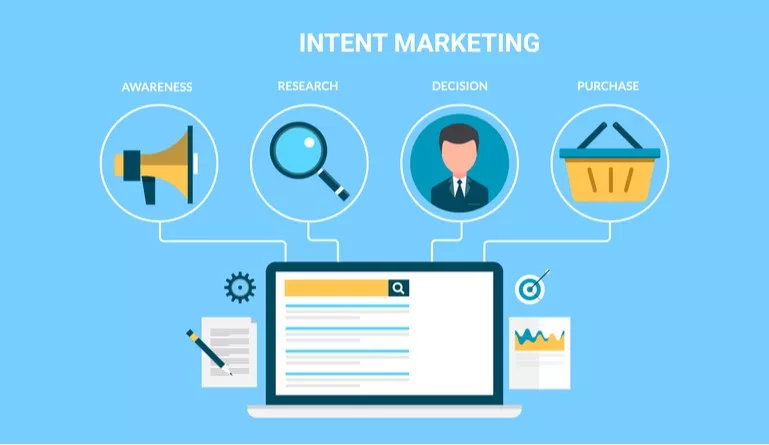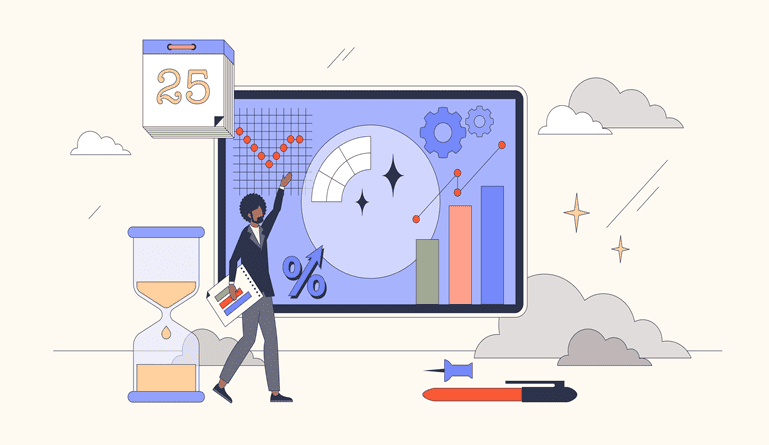Intent based marketing involves marketing a service or product based on a customer’s online actions that indicate their intent to purchase or consume your products or services.
Organizations all around the world are increasing the quantity of data they gather. This massive amount of data gathering paves the way for B2B marketers to increase the effectiveness of marketing campaigns. Intent-based marketing will allow you to make more effective marketing and campaign decisions for your brand.
What Do We Mean by Intent?
-
Intent
This refers to information concerning an individual’s purpose for visiting, according to their actions and behavior online. It is necessary to examine both topic and context data to understand intent.
-
Topic
This is the particular subject of interest that attracts customers to a website. Hence, topic data presents information about a prospect’s interest in a topic your website is offering. However, we cannot rely on only interest as a perfect determinant of purchase intent, which brings us to context.
-
Context data
Offers insight into the nature of an individual’s interest in the topic. For instance, they may be interested in your product and contemplate placing a call through to your sales team. Context data allows you to properly read an individual’s behavioral signals, not to assume something absent, such as deep interest.
-
Surge data
This allows you to know which enterprises are actively browsing your store. Surge data also reveals other intent indicators, like the type of content the audience wants to get from you and when they want it.
Why Does Intent-Marketing Matter?
Intent-based marketing is vital for several reasons. First, it enables you to concentrate on the right prospects and engage them when they are most likely to make a purchase decision.
Intent marketing also empowers enterprises to maximize purchase by boosting higher conversions than with other regular strategies such as demographic-based targeting alone
What Type of Intent Data Should You Focus On?
-
Individual activity data
This type of data gives insight into the visitors’ individual actions and their engagements with the website. It allows you to know essential information so that you can respond on time: Are they first-timers or returning visitors? Which pages are users interested in? Which campaign directed them here?
-
Deep behavioral data
This is the in-depth behavioral monitoring of each visitor on the site. It offers priceless specifics about user activities, including dwell time, page scrolls, clicks, and hovers. Deep data is necessary to understand the true intent and interests of people at the moment. Let us use dwell time as an example. A short dwell time indicates that the visitor most likely stumbled on your page by mistake. On the other hand, a long dwell time indicates active interaction with the site.
What are the Benefits of Intent Marketing?
-
Stop Reaching Out to “The Wrong” Prospects
Buyers will always respond to the businesses that meet their needs. The good thing about intent marketing is that it allows you to channel your focus on the right leads at the right moment. By adopting a marketing strategy that utilizes intent data, you’ll find out what target prospects are browsing and making inquiries before they discover your brand. After that, you can concentrate on providing answers to their questions through your outreach campaigns and targeted ads.
-
Unravel Hidden Opportunities
When launching a new ABM program or new outreach campaign, you’ll start by defining your target accounts. These target accounts will be determined by factors such as technographic, company size, industry, and other crucial indicators that they are a great fit. With intent-based marketing, you can begin to include leads to your campaigns that you are sure are in their buying cycle.
-
Enhance Customers’ Purchase Experience
The incommensurability of information between buyers and sales reps is a typical problem. It makes the purchase experience to be incoherent and potentially complex for customers. Your team can use intent data to understand what problems leads seek to solve and find out what type of content they’re anticipating providing answers to their questions. With this, you can tailor your sales process to meet their specific needs. Businesses that can utilize intent marketing to offer an improved buying experience for their prospective buyers will have a competitive edge in the market.
-
Optimize Your Marketing Resources
Intent-based marketing denotes that you’ll obtain far more insight into the buying journey of your leads. For instance, when you know buyer intent keywords that you’re not answering or identify general questions that you should be addressing on your landing page, your team can update your content strategy to answer those.
Challenges to Intent Marketing
-
Lack of Quality Data
A lot of organizations find it challenging to employ intent-based marketing as a result of insufficient quality data. Your onsite lead scoring and data collection must be perfectly set up if you want to identify purchase signals immediately.
Even if you set up a sales funnel, you’ll still only identify customer intent the moment they’ve engaged your content. The best way to access intent data is to work with an intent data provider, although this can be costly if you pick the wrong provider.
-
Integrating Existing Data with Intent Data
Another challenge to intent marketing is combining intent data with the existing lead scoring systems. The higher the data sources you have, the higher the complexity involved in organizing your data.
Intent Marketing Examples
-
B2B Intent Data
B2B intent data typically offers a more in-depth profile of your prospects. It can provide information like which organization an individual works for, their position in the company, and even the person’s name in some cases.
-
Buyer Intent Software
Due to the increase in demand for this technology, there appear to be countless buyer intent software platforms. While many are designed to function as all-round solutions, some others are more suitable as behind-the-scenes data sources for other platforms.
-
Leadfeeder
Leadfeeder is a good option for people who want to integrate their marketing and sales data. This intent platform helps identify which enterprises are browsing your website, the site pages their workers are visiting, and automatically sends an email to you when a targeted organization visits. Also, whenever a lead returns, Leadfeeder will update your CRM to reflect this.
Where Do You Get Intent Marketing data?
The following are sources from which you can get intent marketing data from:
- Product reviews
- Website visits
- Time on pages
- The content topic on web pages
- Downloads such as whitepapers
Final Thoughts
Indeed, the future is intent-based marketing! The data that your company will gather will only skyrocket. Hence, as a marketer, you can now initiate highly effective marketing campaigns that will yield top-quality B2B leads.






